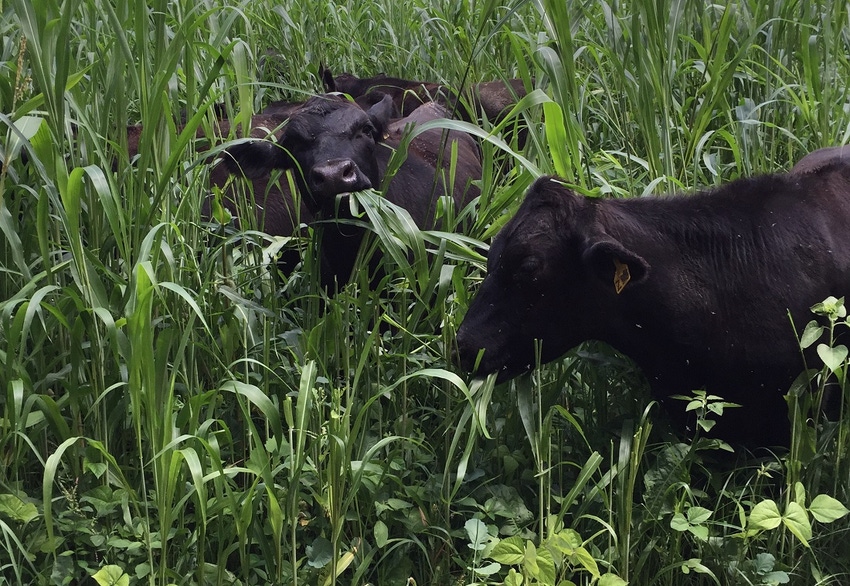
A research demonstration in Ohio shows the potential to improve soil health and potentially profit from a cover-crop and grazing combination.
Chad Bitler and Jonathan Gabis put cover crops on an eight-acre paddock that had wintered cattle every single winter for 10 to 15 years. Although it had fertility, it was weedy and generally in poor shape, Bitler says.
This was on the Greenacres Pasture Research Farm at Cincinnati, an arm of the Greenacres Foundation. It was part of a pasture renovation plan to improve soil health before planting a perennial forage.
In the spring of 2015, they began pasture preparation with heavy grazing, mowing, two trips with an Aerway soil aerator, disking, and planting with a low-till planter. On June 4 they sowed an 18-species, diverse, warm-season cover crop with no added fertility. They drilled a heavy seeding rate of 12 pounds per acre because they wanted to produce the largest possible amount of biomass.
As might be expected, the planting became dominated by the taller, more aggressive species like sorghum-sudan, sunflowers, grazing corn and sunn hemp, Bitler says.
They received 5.39 inches precipitation from planting date until they began strip grazing July 28. This produced 58,000 pounds of total biomass or about 9,000 pounds of dry matter, three weeks of grazing in daily strips (paddocks) of 1/4 to 1/3 acres, and three weeks of grazing for 18 head of mixed stocker cattle weighing from 600 to 1,200 pounds. The average for the group was 3.8 pounds per day and the total pounds of beef produced very close to 6,000.
They grazed without a back fence, therefore they back-grazed for three weeks, but once the calves were moved, the forage regrew to produce 4,500 pounds of dry matter, which they again grazed before terminating the crop and planting a 12-species winter cover crop in early September. Bitler says despite the back-grazing, he believes they left up to one-third of the total forage on the ground to protect and feed the soil.
With the winter forage mix, Bitler says the high residual fertility from the cattle and previous crop really boosted the brassicas in the mix. They dominated, then melted away with the first hard freeze, which left the tonnage available for grazing the next spring lower than optimum. Still they got some reasonable spring grazing with the cow herd, saving 14 days of hay expense.
They followed that summer with a 10-species summer cover crop. This time they did not break the soil surface to plant, and only mowed twice for control. This left some weed pressure and the production was not as impressive and they began grazing in mid September. That data was not included in this article.
The increases in soil health were dramatic, with almost a 1% increase in soil organic matter in that first summer alone, from 3.6% to 4.4%. Haney nutrient testing before, during and after the cover crop treatments showed these benefits:
Total nutrient value increased 121%
Pounds nitrogen per acre increased 78%
Pounds phosphorus per acre increased 133%
Pounds potassium per acre increased 144%
Total organic carbon increased 23%
The Solvita ranking, a measure of soil life, increased by 44%
Economically, the 5,992 pounds of gain they put on feeder and finisher calves must be ranked as a win. If valued at a pasture cost of 70 cents per pound, the gross value could be worth almost $4,200.
Bitler and Gabis calculate it cost a total of $1,516 in labor and seed expenses for one full cycle of warm-season and cool-season cover cropping, with no charge for equipment and fuel. That would be offset by gains in soil nutrient content and water-holding capacity, which would at least decrease fertilization costs and increase drought resistance.
Over time, such improvements could be expected to increase production, as well.

The improvements in soil health from one year of summer and winter cover cropping and grazing are summarized on this graph.
About the Author(s)
You May Also Like




